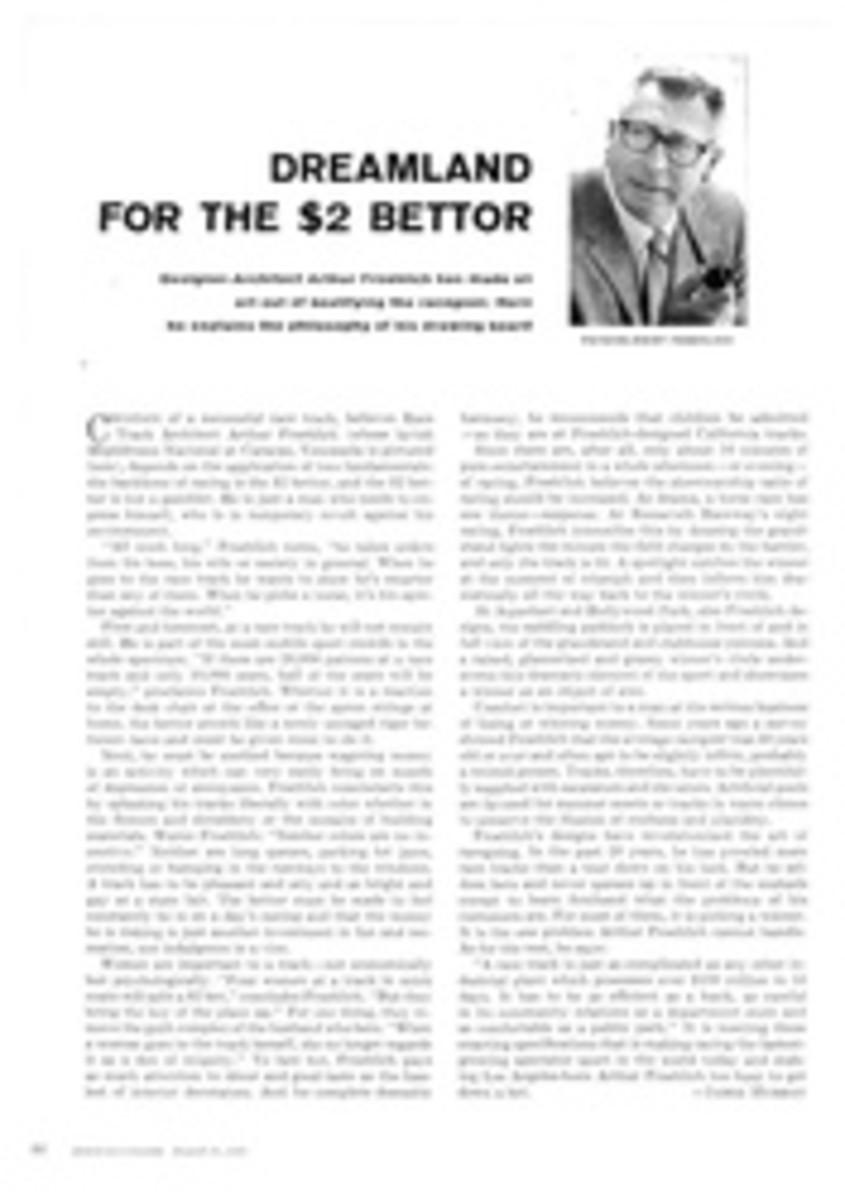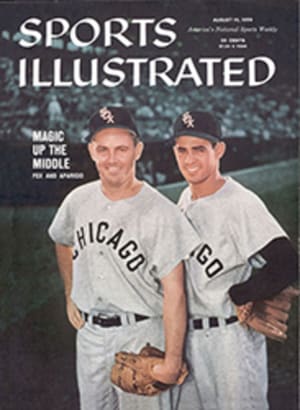
DREAMLAND FOR THE $2 BETTOR
Creation of a successful race track, believes Race Track Architect Arthur Froehlich (whose lavish Hipódromo Nacional at Caracas, Venezuela is pictured here), depends on the application of two fundamentals: the backbone of racing is the $2 bettor, and the $2 bettor is not a gambler. He is just a man who needs to express himself, who is in temporary revolt against his environment.
"All week long," Froehlich notes, "he takes orders from his boss, his wife or society in general. When he goes to the race track he wants to show he's smarter than any of them. When he picks a horse, it's his opinion against the world."
First and foremost, at a race track he will not remain still. He is part of the most mobile sport crowds in the whole spectrum. "If there are 20,000 patrons at a race track and only 10,000 seats, half of the seats will be empty," proclaims Froehlich. Whether it is a reaction to the desk chair at the office or the apron strings at home, the bettor prowls like a newly uncaged tiger between races and must be given room to do it.
Next, he must be soothed because wagering money is an activity which can very easily bring on moods of depression or annoyance. Froehlich counteracts this by splashing his tracks liberally with color whether in the flowers and shrubbery or the mosaics of building materials. Warns Froehlich: "Somber colors are no incentive." Neither are long queues, parking lot jams, crowding or bumping in the runways to the windows. A track has to be pleasant and airy and as bright and gay as a state fair. The bettor must be made to feel constantly he is on a day's outing and that the money he is risking is just another investment in fun and recreation, not indulgence in a vice.
Women are important to a track—not economically but psychologically. "Four women at a track in mink coats will split a $2 bet," concludes Froehlich. "But they bring the key of the place up." For one thing, they remove the guilt complex of the husband who bets. "When a woman goes to the track herself, she no longer regards it as a den of iniquity." To lure her, Froehlich pays as much attention to decor and good taste as the fussiest of interior decorators. And for complete domestic harmony, he recommends that children be admitted—as they are at Froehlich-designed California tracks.
Since there are, after all, only about 16 minutes of pure entertainment in a whole afternoon—or evening—of racing, Froehlich believes the showmanship ratio of racing should be increased. As drama, a horse race has one theme—suspense. At Roosevelt Raceway's night racing, Froehlich intensifies this by dousing the grandstand lights the minute the field charges on the barrier, and only the track is lit. A spotlight catches the winner at the moment of triumph and then follows him dramatically all the way back to the winner's circle.
At Aqueduct and Hollywood Park, also Froehlich designs, the saddling paddock is placed in front of and in full view of the grandstand and clubhouse patrons. And a raised, glamorized and grassy winner's circle underscores this dramatic element of the sport and showcases a winner as an object of awe.
Comfort is important to a man at the serious business of losing or winning money. Some years ago a survey showed Froehlich that the average racegoer was 50 years old or over and often apt to be slightly infirm, probably a retired person. Tracks, therefore, have to be plentifully supplied with escalators and elevators. Artificial pools are favored for summer meets or tracks in warm climes to preserve the illusion of coolness and placidity.
Froehlich's designs have revolutionized the art of racegoing. In the past 20 years, he has prowled more race tracks than a tout down on his luck. But he seldom bets and never queues up in front of the mutuels except to learn firsthand what the problems of his customers are. For most of them, it is picking a winner. It is the one problem Arthur Froehlich cannot handle. As for the rest, he says:
"A race track is just as complicated as any other industrial plant which processes over $100 million in 55 days. It has to be as efficient as a bank, as careful in its community relations as a department store and as comfortable as a public park." It is meeting these exacting specifications that is making racing the fastest-growing spectator sport in the world today and making Los Angeles-born Arthur Froehlich too busy to get down a bet.
PHOTO
PSYCHOLOGIST FROEHLICH
PHOTO
ARCHITECT'S MODEL of giant new $66 million "dream track" in Caracas, Venezuela points up Designer Arthur Froehlich's preoccupation with bright pastels and creature comforts for Thoroughbred racegoers. Froehlich, who designed California's elegant Hollywood Park as well as New York's Roosevelt Raceway and Aqueduct (due to open Sept. 14), believes Caracas track is his finest work.

